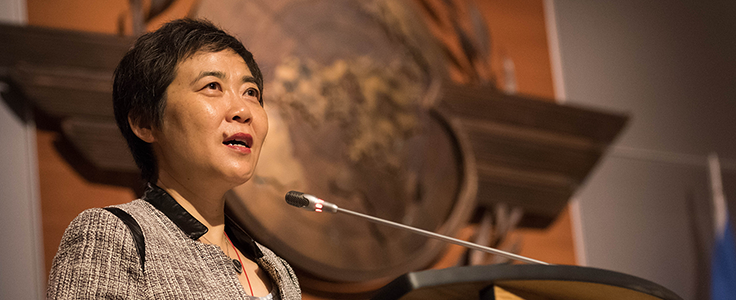
Mme Liu, Secrétaire générale de l'OACI, a prononcé l'allocution d'ouverture du 13e Symposium sur la stratégie du Programme d'identification des voyageurs (TRIP) de l'OACI, qui se tient au siège de l'institution onusienne à Montréal. Rendez-vous mondial portant sur la gestion des documents de voyage et de l'identité, ce tout dernier Symposium TRIP est considéré comme une étape importante pour maintenir l'élan mondial à l'égard des priorités de lutte anti-terroriste qu'a récemment suscité le Conseil de sécurité des Nations Unies.
Montréal, le 26 octobre 2017 – La lutte contre les mouvements terroristes et criminels internationaux a franchi une étape cette semaine, alors que des experts et des hauts fonctionnaires se sont réunis à l'occasion du 13eSymposium sur la stratégie du Programme d'identification des voyageurs (TRIP) de l'OACI.
« La stratégie TRIP de l'OACI renforce la ligne de défense mondiale contre les mouvements terroristes internationaux, la criminalité transfrontalière et les nombreuses autres menaces qui pèsent sur la sécurité et la sûreté de la société civile et de l'aviation internationale », a fait valoir Mme Liu, Secrétaire générale de l'OACI, dans son allocution d'ouverture.
« La majorité de nos travaux dans ce domaine sont principalement réalisés conformément à l'Annexe 9 à la Convention de Chicago – Facilitation. Les activités de facilitation appuient résolument les Objectifs de développement durable (ODD) des Nations Unies et la Stratégie TRIP de l'OACI contribue de manière importante aux Résolutions 2178 et 2309 du Conseil de sécurité des Nations Unies. »
Rendez-vous mondial portant sur la gestion des documents de voyage et de l'identité, ce tout dernier Symposium TRIP est considéré comme une étape importante pour maintenir l'élan mondial à l'égard des priorités de lutte anti-terroriste qu'a récemment suscité le Conseil de sécurité des Nations Unies.
Mme Liu avait présenté un exposé général de la sûreté de l'aviation au Conseil de sécurité des Nations Unies en septembre, après avoir été invitée à la réunion du Comité contre le terrorisme (CTC) en juillet 2017. Outre le renforcement des inspections/filtrages et des contrôles de sûreté, le CTC a souligné l'importance du rôle des compagnies aériennes dans le suivi des déplacements dans le monde des passagers présentant un risque plus élevé.
« Le CTC a expressément reconnu l'importance du partage des renseignements préalables concernant les voyageurs (RPCV) par les autorités nationales », a noté Mme Liu. « Bien que de nombreux États n'aient toujours pas mis en place des programmes relatifs aux RPCV, je tiens à leur rappeler que le partage des RPCV est obligatoire depuis le 23 octobre dernier, en vertu de l'Annexe 9 de l'OACI ».
Les séances tenues dans le cadre du Symposium TRIP 2017 ont permis aux participants de s'informer sur les dernières mesures d'inspection/filtrage et de sûreté fondées sur les risques, tout en soulignant l'importance des partenariats et du renforcement des capacités alors que les États œuvrent à renforcer leurs lignes de défense respectives.
« La mise en œuvre par les États de la stratégie TRIP nécessite une action coordonnée entre de nombreux États et entités de l'industrie, mais nous sommes aussi conscients que les divers gouvernements ne disposent pas des mêmes capacités à mettre en œuvre le Programme TRIP. L'OACI et les États s'emploient à résorber cet écart en favorisant la coopération entre les États et l'industrie, en renforçant la coordination régionale et locale, et en obtenant la contribution de donateurs », a indiqué Mme Liu.
La question des orientations approfondies dont ont besoin les États pour la planification et la mise en œuvre du programme TRIP a été abordée plus en détail dans le cadre du lancement du Recueil TRIP de l'OACI. Ce nouveau document de référence exhaustif présente les initiatives connexes de partenaires tels que l'Office des Nations Unies contre la drogue et le crime (ONUDC), INTERPOL, l'Union européenne, l'Organisation pour la sécurité et la coopération en Europe (OSCE) et l'Organisation mondiale pour les migrations (OIM), et rassemble divers éléments indicatifs de l'OACI supplémentaires.
Le Symposium TRIP 2017 a coïncidé avec deux ateliers OACI importants sur le Répertoire de clés publiques (RCP) et l'adoption de nouvelles approches en matière de RPCV, tenus en parallèle et en partenariat avec la Direction exécutive du Comité contre le terrorisme (DECT) des Nations Unies et d'autres organisations internationales. Si le Panama est récemment devenu le 59e État à tirer profit de la validation encryptée du RCP, qui maximise les avantages de la sûreté des passeports électroniques, Mme Liu a souligné que l'OACI s'attend à ce que davantage d'États adhèrent au RCP dans les mois à venir.
« S'il est vrai que plus de 80 % des passeports électroniques en circulation dans le monde sont délivrés par des États qui participent déjà au RCP, de nombreux États ne s'en prévalent toujours pas pour authentifier les données contenues dans la puce », a-t-elle réitéré.
Le Symposium TRIP 2017 était centré sur le thème « Renforcer la sûreté et l'efficacité du transport aérien », pour refléter le fait que des technologies de sûreté bien conçues contribuent aussi à l'amélioration de l'expérience des passagers et, de manière plus générale, de l'efficacité des processus de facilitation.
« C'est uniquement en nous assurant d'équilibrer ces deux priorités que les solutions que nous proposons seront véritablement durables », a conclu Mme Liu.
Outre le Symposium et ses ateliers, les participants à l'édition 2017 ont pu visiter une exposition éclectique présentant les dernières innovations de l'industrie en matière de technologies et de processus. Le Symposium a rassemblé près de 600 fonctionnaires venant de 82 États et de 14 organisations internationales et prendra fin aujourd'hui à l'OACI.
https://www.icao.int/Newsroom/Pages/FR/ICAO-traveller-identification-event-highlights-key-aviation-role-in-combatting-terrorism-and-cross-border-crime.aspx

